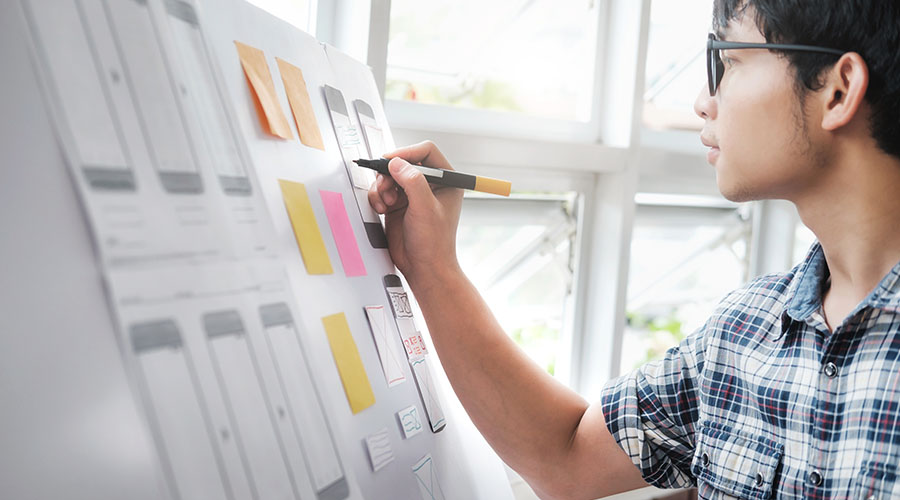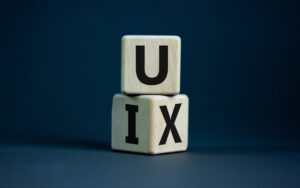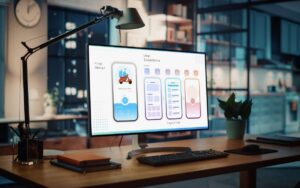User experience, UX for short, is a vital aspect of product design that focuses on enhancing the usability, accessibility, and desirability of a product. UX design lies at the heart of creating seamless and enjoyable user experiences on your favorite websites or apps.
Usability Geek’s founder, Justin Mifsud, famously shared that 88 percent of people are less likely to return to a website after interacting with a bad UX. No wonder top companies consider UX design a significant investment area that heavily impacts their products’ success.
In this article, we’ll take you through everything you need about the UX design process, from research and analysis to design and launch. Whether you’re a designer, developer, or just interested in the world of UX, we’ve got you covered with tips and insights to help you create products that users will love.
Read on if you want to learn more about the UX design process. Also, check out this UX/UI design bootcamp, which will help you learn what it takes to create successful digital user experiences.
What is UX Design?
User experience (UX) design is a process that design teams use to create products that provide meaningful and relevant experiences to users. The primary goal of UX design is to ensure that the product is easy to use and addresses the pain points and needs of the users.
Designing the Entire User Experience
UX design involves designing the entire process of acquiring and integrating the product. It includes not only making the software easy to use but also designing the other experiences related to the product, such as the marketing campaign, packaging, and after-sales support.
ISO Definition of User Experience
The International Organization for Standardization (ISO) defines user experience as a person’s perceptions and responses resulting from using or anticipating a product, system, or service. We can break this definition into two parts: a person’s perceptions and answers and their use of a product, system, or service.
Design for User Experience
Designers cannot control a person’s perceptions and responses but can control how the product, system, or service behaves and looks. Therefore, UX design is all about designing for the user experience, not the experience itself.
UX Design as a Verb and a Noun
The simplest way to think about UX design is as a verb and a noun. A UX designer designs (verb) the things that affect the user experience (noun), such as perceptions and responses to a system or service.
Also Read: How to Write a UX Designer Resume
What is a UX Design Process?
User research is the foundation of the UX design process. At this stage, designers gather insights about the target audience, their needs, behaviors, and pain points. This information is critical to creating experiences that solve real-world problems for users.
Conduct User Research
Designers use various qualitative and quantitative methods, such as interviews, surveys, and analytics data to conduct user research. Through these methods, designers can gain a deep understanding of the target audience, their motivations, goals, and behaviors.
Analyze the Market and Competitors
In addition to user research, designers analyze the market and competitors’ products to identify gaps and opportunities. This helps them determine where their product fits in the market and how it can stand out.
Define the User Problem
Based on research insights, designers define the user problem to solve and establish design goals and objectives. Creating user personas, scenarios, and user stories is also crucial to guide the design process and ensure the product is tailored to users’ needs.
Design Thinking and Visual Design
The design stage involves using design thinking to generate ideas and create sketches, wireframes, and mockups. At this stage, designers develop a visual design language, including color, typography, imagery, and other design elements. Creating a site map and user flow helps visualize the user journey and how users interact with the product.
Prototype and Iterate
The next stage involves building a clickable prototype or a minimum viable product (MVP) to test the design concept and gather user feedback. Based on user feedback, designers iterate on the design and improve the product.
Validate and Test
The design is then tested with real users to validate assumptions and identify areas for improvement. Conducting usability testing and user acceptance testing (UAT) ensures the design meets user needs and expectations.
Build and QA Testing
With the design validated, designers develop the final product design and user interface (UI). They work with developers to integrate the design into the product and ensure it functions as intended. Conducting quality assurance testing identifies and fixes any issues or bugs in the product and ensures it meets all relevant technical and functional requirements.
Launch and Collect Feedback
Finally, the product is released to the market, and its performance is monitored. User feedback and analytics data are collected to inform future design iterations and product improvements. The UX design process is an ongoing cycle of continuous improvement that helps create experiences that meet users’ evolving needs.
Also Read: A Look at 10 Great UX Portfolio Examples
A Practical Approach to the UX Design Process
Now, let us dive deeper into the practical approach to the UX design process. Now that we know what happens in the UX design process, let us look at how it translates into actual work. We’ll focus on the tangible steps and methods you can take to create a successful user experience.
Step 1: Understand
Understanding Your User
To create a successful user experience, you need to understand your user’s pain points. Ask yourself: What problem are you trying to solve for your user? Why are you the one with the answers? Brainstorming to answer these questions might take some time, but it’s worth it. Once you understand your user’s problems, you can create a strategy for design success.
Understanding Your Brand
The second element you need to understand is how the project aligns with your brand’s mission and goals. Ask yourself: What are your company’s values and mission? How does this project contribute to that goal? Is this the right time for your company to pursue this project? Keeping in line with your brand’s core mission is crucial to the success of your project and business.
Tips for Understanding Your User and Brand
- Use boards to share design assets quickly, create mood boards, and more.
- Conduct user research to gain a deeper understanding of your users.
- Keep in line with your brand’s core mission to stay true to your values and goals.
The Power of Keeping in Line with Your Brand
Southwest Airlines is a prime example of a company that has succeeded by keeping in line with its core mission. By sticking to its promise of being “THE low-fare airline,” Southwest has become one of the most profitable airlines in the world. By staying true to your brand’s mission and values, you can create a successful project that aligns with your company’s goals.
So, before you start any design project, take the time to understand your user and your brand. By doing so, you’ll create a solid foundation for design success.
Stage 2: Research – The Foundation of Your Project
Once you have identified your project’s alignment with your brand and determined the problems facing your users, the next step is to conduct user research. This stage is vital as it lays the foundation for how your entire project will turn out. The user research you conduct should challenge all your assumptions and should include the following methods:
1:1 Interviews
One-on-one interviews are when you sit down with someone from your target audience and ask them specific questions about their issues. You can ask them what they are struggling with and what they are looking for in your product. Face-to-face interviews are the best as you can gauge their verbal and nonverbal reactions, but video or phone calls can also work. You can use tools like Zoom for video conference calls, Lookback to record interviews, and Temi to transcribe calls.
User/Focus Groups
Encouraging dialogue between the participants and yourself can lead to interesting insights. That’s what focus groups are all about. Tools like FocusGroupIt for easy group moderation, a video camera for recording the group, and a voice recorder for recording the group can be helpful. Through this method, you can gauge your target users’ attitudes, emotions, and frustrations with an issue or product.
Surveys
These are questionnaires you send out to your target users. Surveys are good for determining your users’ attitudes toward a specific topic, and you receive the data as soon as the users complete the survey. However, you must be careful not to use leading questions that could disproportionately impact the results. Online survey tools like Wufoo, TypeForm, and Google Surveys can be helpful.
Usability Testing
This is observing your target audience using a program or product. You can ask your users to use your product, watch how they act and react, and then ask them questions about their experience. This is an excellent opportunity to see how happy your user is with the product and if it adequately addresses their needs. Tools like User Testing to run a user test on your website, Optimizely for good A/B testing, and Click Heat to find out what users are clicking on can be beneficial.
You can uncover critical insights about your users’ needs and pain points by conducting thorough user research. This information will allow you to create user-centered designs that solve your users’ problems. Ultimately, user research sets the tone for the entire design process and helps ensure that your final product meets the needs of your users.
Stage 3: Analyze
In the third stage of your design process, you will analyze and distill the information you gathered in the previous stages to create a clear picture of your users and their needs. Analyzing your user research is a critical step in the design process. User personas and user journey maps provide a clear understanding of your users and their needs. They also help you make design decisions that cater to their specific needs.
User Personas
User personas are profiles of your ideal customer. They clearly understand the people you are designing for and help you make design decisions catering to their needs. A good persona should include information on their goals, background, age, gender, behaviors, spending habits, pain points, and needs.
You can create multiple personas to represent your different types of users. Persona templates can help guide you through the creation process.
User Journey Maps
A user journey map represents the user’s interactions with your product or service. It visually represents how a user navigates through your product or service from start to finish. A good journey map can help build empathy, provide a typical “big picture,” break down silos, bring focus, and reveal opportunities.
To create a user journey map, use the information you gathered in the research phase to understand what your user will be going through when using your product or service. Only then can you design a product that caters to their specific needs.
Stage 4: Design
Building the Design: Wireframes and More
Now that you’ve done your research and analysis, it’s time to put all that information to use and start building your design. This is where you turn your ideas into something tangible.
Building the Layout
To start, you need to create a site map and user flow to establish the structure of your design. This will allow you to plan how users navigate your product or service.
After that, you can create mockups, images, icons, and colors. But creating a wireframe is important before you get too far into the design.
Wireframes: The Bare Essentials
Wireframes are the foundation of your design. They’re low-fidelity prototypes that visually represent your product or service. They don’t include high-quality images or fancy design elements, but they help you visualize the basic structure and layout of your design.
Wireframes are essential because they help you accomplish three things:
- Present information that will be displayed on the page
- Give an outline of the structure and layout of the page
- Convey overall direction and description of the user interface
Creating a wireframe is an iterative process. You’ll need to design, redesign, and refine your wireframe until you’re happy with the overall structure and layout.
It’s important to remember that wireframes are not the final product; they’re simply a tool to help you plan out the user experience. As you move through the design process, you’ll gradually add more design elements and refine your wireframes to create a more polished final product.
Stage 5: Launch
After going through the process of designing and redesigning, it’s time to launch your product. The launch is the most exciting part of the process but can also be pretty nerve-wracking. You want to ensure everything is perfect before it hits the market. Here are some tips to ensure a successful launch.
Transform Designs into Clickable Prototypes
Before the development team can create a high-fidelity version of the user interface, you need to transform your static designs into clickable prototypes. This will give your team a sense of how the product will work and enable them to refine it further.
Ways to Ensure the Product is Perfect
There are several ways to ensure the product is perfect or close to it.
- User testing: Observe your target audience using the actual program.
- Beta launch: A limited release of your product to a small number of people to find issues and clean them up before you launch it to the world.
- Internal testing: When your team uses the product, they test each facet.
- Feedback with the development team: Crucial at this stage. You want to ensure that you communicate any issues that arise and that they are addressed before your product launches.
The Launch is Just the Beginning
Remember, the launch is just the beginning of your product’s journey. You’ll need to continuously test and refine your product as your users interact with it. You’ll also need to market and promote your product to ensure it gets in front of the right people. So, take a deep breath and enjoy the moment. You’ve come a long way, and your hard work is about to pay off.
Stage 6: Re-Analyze
Reflecting on the Final Product and Process
After all the hard work and effort put into creating and launching your product, it’s a good idea to take a step back and analyze the final result. Here are some questions to ask during this final stage of the UX process:
What Went Right and Wrong?
Look back on the process as a whole and identify what went right and what went wrong. What was successful, and what didn’t quite hit the mark? Try to understand the factors that contributed to both successes and failures.
How Are Users Responding?
Take a look at how your users are responding to your product.
- Are they satisfied? Are they finding it easy to use? Are there areas that need improvement?
- Did the Product Solve User Pain Points?
- Did your product solve the pain points you identified during the research stage? If not, why not? What can you do to address these issues in the future?
- How Can the Product Be Improved?
- What areas of the product can be improved? What improvements can be made to the overall user experience? Are there any features that are confusing or not working as intended?
Lessons Learned for Future Products
Finally, take some time to reflect on the entire UX process. What lessons have you learned that you can apply to future products? What worked well, and what can be improved? By reflecting on and analyzing the UX process, you’ll gain valuable knowledge and insights you can leverage for future projects.
Also Read: UX/UI Portfolio Tips: How to Showcase Your Work and Skills
Why is UX Design Important?
Save Money and Improve Results with UX Design
Investing in UX design at the beginning of a project may seem unnecessary, but it can save you a significant amount of money in the long run. When you invest in UX design upfront, you can catch problems early on, which reduces the cost of fixing them later.
Boost Your Business with Great User Experience
Good UX design can help you increase your conversions by making it easy for your users to complete their desired actions. When you create a smooth and intuitive user experience, your users are more likely to engage with your product or service, resulting in higher conversion rates.
Enhance Your Website’s Visibility with UX Design
Search engines like Google prioritize websites that are easy to use and provide a good user experience. UX design can help you create a website that is easy to navigate, loads quickly, and provides valuable content, which can help boost your search engine rankings.
Build a Stronger Connection with Customers through UX Design
Good UX design can help you build brand loyalty by creating a positive user experience that your customers will remember. When your customers have a positive experience with your product or service, they are more likely to return, leave positive reviews, and recommend your brand to others.
Amplify Your Reach with UX Design and Happy Customers
Finally, good UX design can help increase word-of-mouth referrals. When your customers have a positive experience with your product or service, they are more inclined to share it with their friends and family, leading to more organic referrals and increased brand awareness.
Learn the UX Design Process and More Skills for a Successful UX/UI Design Career
Understanding the UX design process is crucial for anyone who wants to build a successful digital product. From conducting user research to creating high-fidelity prototypes, each step plays a vital role in creating a seamless and intuitive user experience. By investing time and effort into the UX design process, businesses can significantly reduce costs down the line, increase conversions, and build brand loyalty.
For an aspiring UX designer, mastering the UX design process and gaining other key skills, such as design thinking, persona mapping, prototyping, usability testing, etc., is crucial to carving out a rewarding career. A reputed UX/UI bootcamp like Caltech CTME offers in collaboration with Simplilearn can help you with this.
The program covers everything you need to boost your skills and advance your UX/UI design career. Get trained by industry experts, work on capstone projects, and get job assistance and networking opportunities.






